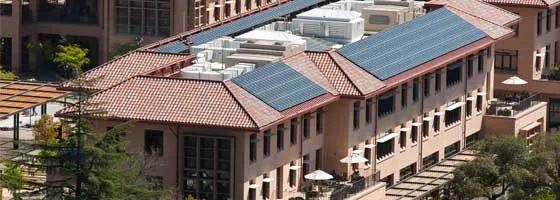Knight Management Center Awarded LEED Platinum Rating
The eight-building complex designed to support an innovative MBA curriculum achieved a LEED Platinum rating for environmental sustainability.
March 15, 2012
The U.S. Green Building Council has certified the Knight Management Center at the Stanford Graduate School of Business as LEED Platinum®, the highest rating for environmental sustainability.
Photovoltaic panels harvest enough solar energy to power 12.5% of the complex’s annual energy demand.
The Knight Management Center opened in April 2011 as a new home for the school’s innovative MBA curriculum and other programs, and as a physical space intended to both bring students together from across Stanford University’s seven schools for interdisciplinary learning and demonstrate the Graduate School of Business’ commitment to environmental leadership. “As we train new generations of managerial leaders, we hope that Stanford’s commitment to sustainability will inspire our students to promote sustainable business practices in the future,” said Garth Saloner, dean of the Stanford Graduate School of Business.
Filled with natural light and the latest technology, the 360,000-square-foot facility underscores what is taught in many of the school’s electives such as Environmental Entrepreneurship and Environmental Science for Managers and Policy Makers, as well as in core classes covering sustainability across the functions of business, and in its MBA/MS Environment and Resources joint-degree program.
During the accreditation process, the Knight Management Center received 60 points, more than the minimum 52 points required for the LEED Platinum version 2.2 rating. Green aspects of the building that contribute to its high sustainability rating include building and landscape design and optimized energy and water use:
- The relatively narrow dimensions of the classroom buildings and floor-to-ceiling glass maximize the amount of daylight entering the building, significantly reducing the need for electric lighting; 90% of interior work spaces are illuminated by daylight and room lights turn off automatically when a room is emptied, reducing the electricity load.
- Photovoltaic panels on the roof harvest enough solar energy to power 12.5% of the complex’s annual energy demand. The Knight Management Center’s eight buildings exceed current state energy standards by 45%. For example, more efficient under-floor air distribution systems replace forced air systems, and air-handling units recapture waste heat and redistribute it where it is needed. During summer months, the building employs night flushing systems, as well as automated skylights and windows, to release the hot air of day and draw in cool air overnight.
- The center has reduced potable water usage for sewer conveyance by 80% by using grey water and rainwater.
- Fifty percent of the site is devoted to open space, and parking for 900 cars is underground.
Built across the street from the beautiful Schwab Residential Center for MBA students and executive education participants, the Knight Center design fosters an integrated living and learning environment. Indoor and outdoor spaces seamlessly blend with walls that fold open to the outside for increased interaction in social areas including the circular Arbuckle Dining Pavilion.
Stanford’s Sustainable Master Plan Legacy
Frederick Law Olmsted’s master plan for Stanford University, developed in the late 1800s, set the Main Quad as the dominant feature of the campus. For the 21st century and beyond, Stanford has embarked on a mission to build on and restore the original master plan by reinforcing Serra Street as the primary east/west axis for the campus. Placing the Graduate School of Business at the east end of Serra Street, with the School of Medicine at the west end, strengthens the importance of Serra Street as the primary campus link.
The east/west axis is also the ideal orientation for sustainable building design. The Knight Management Center takes advantage of the southern exposure to reduce the need for artificial lighting, while the long north orientation allows the buildings to take advantage of the Mediterranean climate through the use of operable windows providing natural ventilation to many interior spaces.
For media inquiries, visit the Newsroom.
Explore More
Alyssa Rapp, MBA ’05: What Matters to Me Now and Why

Catalyst: Too many students are missing school. This company hopes to fix that.

Catherine Roberts Joins Stanford GSB as CCMO
